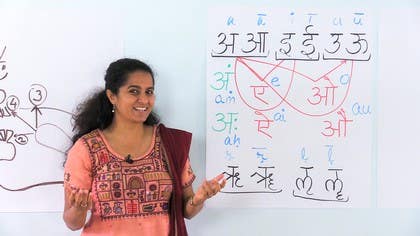Description
About This Video
Transcript
Read Full Transcript
Namaste dear friends, welcome back again. In our previous session we looked at how the Sanskrit alphabet corresponded to the different parts of the human vocal system. So we had the five places, the throat or the guttural, the palatal, the cerebrals which corresponds to the roof of your mouth, the center of the roof of your mouth, the teeth, the dentals and then the labials. We looked at the vowels that again corresponded to these five places of pronunciations. We sounded the sixteen vowels.
Now let's look at how these letters look and we will also try and correspond them to the different fingers that we sounded them along with. We have the first two vowels, the a and the a. Feel free to make the sounds as often as you can, that helps. I'll also put the English-Roman transcription of it so it's easy to follow. And this can be considered as a couple in a sense.
The second vowels that we had, the primary sounds were ee, ee and they look like this ee, ee, that's it, they look a bit like snakes, ee, ee, ee, ee, ee, ee, ee, ee, ee, ee, ee, ee and the English transliteration is ee, ee, that's the second couple that we have. The next two primary sounds were the oo, oo, let's see what they look like. You can also say it along with me, oo, oo and the vowel in transcript form is oo, oo, that's the third couple that we have. So the first are the ah, ah, ee, ee, oo, oo. So the three primary vowels that we have are the ah, ah, ee, ee, oo, oo and they correspond to the first three fingers, ah, ah, ee, ee, oo, oo.
We have two more sets of primary vowels, they are the rr, rr, lr, lr, the rr, lr corresponds to the cerebral part of our mouth and the rr, rr correspond to the dentals and they look like this, rr, rr. So this is the next one, we have rr, rr and then we have rr, rr, rr, there we go and in transliteration it is rr, rr, rr, rr. So here we have the primary vowels which correspond to these five places of pronunciation. We have the ah, ah, the first finger, the short and the long vowels, ah, ah, then the ee, ee which correspond to your index finger, ee, ee, then the oo, oo which correspond on the third finger, the oo, oo, then you have the rr and rr here corresponding to the cerebral and then you have the rr, rr. These two letters hardly figure in the Sanskrit language, but they exist because of the representation of the perfection of the sounds of the vowels.
We will next look at the combinations, we have the ah and the ee and when you combine them in between you get the ee and we can represent it like this. So we have a, see that again, a and the next one which was a combination of the two is the i and this is how it looks, i. So we have the a, I will show to you in transliteration, it's the a and that is the i. The next two combinations that we had were the oo and the owl. So we had a, i, between the a and the oo we have the oo, oo and owl.
Let's see what they look like, even put an arrow. So we have the, that's the oo and then we have the, that's the owl. So when we combine the a and the oo we get the oo and in transliteration it looks like that and you have the owl which is a and u together. The final two vowels that we have are the anuswara or the am, the nasalized sound and it looks like this. It's a combination of the a with the nasal um or un and it is written as um and the last visarga is the ah.
So you can hear the sound, the vowel a followed by the aspirate ah and it's written as such. The transliteration is ah. So there we have the representation of all the Sanskrit vowels. Now let's see if we can sound them together, so a, a, i, i, u, u, z, z, l, l, e, i, u, a, u, um or un, ah. Now let's see if we can do it on the finger.
The more you repeat the sounds the better it is. In any, any language you learn for that matter, the more you sound it, the more your system gets tuned into that particular sound. So let's see if we can represent this once more on our fingers. So see if you can combine what you see along with the representation on it on your hand. So a, a, i, i, u, u, z, z, l, l, between the ah and the i, i, i, between the ah and the u, u, a, u, um, ah.
I hope you got it, it's not very difficult but yeah, enjoy doing these sounds again. Play with them as much as you can, just try and feel them in your mouth and I bet you're going to get it soon.
Mother Tongue: The Sound of Sanskrit
Comments
You need to be a subscriber to post a comment.
Please Log In or Create an Account to start your free trial.














